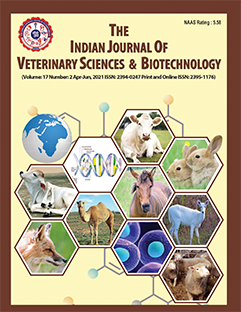Evaluation of Efficacy of BovEasy Bovine Rapid Pregnancy Detection Kits in Crossbred Cattle
DOI:
https://doi.org/10.48165/ijvsbt.21.3.06Keywords:
BovEasy bovine rapid PD kit, Crossbred cattle, Efficacy, Plasma progesterone, Pregnancy associated glycoproteins (PAGs), UltrasonographyAbstract
Bovine early pregnancy detection is a boon to optimize reproductive rhythm and economic dairy entrepreneur. This study evaluated the efficacy of different early pregnancy detection methods in crossbred cows on the University Farm. In all 80 freshly inseminated crossbred cattle, which did not return to estrus within 22 days post-mid-estrus AI were included in the study. Blood samples were collected in EDTA/ clot activator vaccutainers on days 21, 28, 32, 36, and 45 post-AI for various tests. Transrectal ultrasonography was performed on day 28 post-AI at random on 45 animals. BovEasy bovine rapid PD kits were used on fresh whole blood on days 28, 32 and 36. Blood plasma samples were analyzed for progesterone by RIA technique on all days, and for pregnancy associated glycoproteins (PAGs) on day 28 and 36 post-AI by using ELISA kits. Final pregnancy was confirmed by actual per rectal palpation on day 45 post-AI. Out of 80 cows, 38 (57.50 %) were confirmed to be pregnant by day 45 post-AI. However, by early PD kits, the animals declared pregnant on days 28, 32 and 36 were 41, 40 and 40, respectively, with suspicious results in 5, 2 and 2 animals. The accuracy, specificity and sensitivity of rapid test kits recorded were 93.75, 95.24 and 92.00% on day 28 post-AI, and 97.50, 97.62 and 97.00% on day 32 as well as 36 post-AI, respectively. The plasma progesterone concentrations showed a significant (p<0.05) increase in the levels from day 21 to day 45 in conceived subgroup with significantly higher values than in non-conceived subgroup. The plasma PAG in conceived subgroup was significantly (p<0.001) higher than in non-conceived subgroup on both the days of testing, with around 1.5 to 1.7-fold increase on day 36 compared to day 28 in conceived subgroup. The accuracy of positive pregnancy on day 28 post-breeding was 100% by both plasma progesterone and USG, and 97% by plasma PAGs. The study also recorded 10.00% early embryonic mortality in crossbred cattle.
Downloads
References
Akköse, M. (2023). Comparative evaluation of two commercial pregnancy-associated glycoproteins tests for early detection of pregnancy in dairy cattle. Theriogenology, 200, 11-17.
Balhara, A.K., Gupta, M., Singh, S., Mohanty, A.K., & Singh, I. (2013). Early pregnancy diagnosis in bovines: Current status and future directions. Scientific World Journal, 2013, 958540.
Barbato, O., Menchetti, L., Sousa, N. M., Malfatti, A., Brecchia, G., Canali, C., Beckers, J. F., & Barile, V. L. (2017). Pregnancy-
associated glycoproteins (PAGs) concentrations in water buffaloes (Bubalus bubalis) during gestation and the postpartum period. Theriogenology, 97, 73-77.
Barbato, O., Menchetti, L., Brecchia, G., & Barile, V.L. (2022). Using pregnancy-associated glycoproteins (PAGs) to improve reproductive management: from dairy cows to other dairy livestock. Animals (Basel), 12(16), 2033.
Borakhatariya, D.N., Singh, V.K., Karangiya, V.K., Vijyeta, H P., Vala, K.B., & Padodara, R J. (2024). Relationship of the pregnancy, stress biomarkers and embryonic losses in Jaffrabadi buffaloes during summer season. Indian Journal of Veterinary Science and Biotechnology, 20(6), 85-89.
Dana, O. I., Mukhtar, R. H., Mohammed, M. O., & Dyary, H. O. (2021). Comparison of a rapid test with bPAG ELISA in pregnancy diagnosis in cows. Iraqi Journal of Agricultural Sciences, 52(6), 1475-1481.
Devmurari, Y.J. (2025). Comparative efficacy of different methods of early pregnancy diagnosis in cattle and buffaloes. MVSc Thesis. Kamdhenu University, Junagadh, Gujarat, India.
Devmurari, Y.J., Vala, K.B., Parikh, S.S., Vijyeta, H.P., Dhami, A.J., & Solanki, J.Z. (2025). Comparative efficacy of PAG-based rapid strip test kit, ultrasonography and per rectal palpation for early pregnancy diagnosis in cattle and buffaloes. The Indian Journal of Veterinary Sciences & Biotechnology, 21(2), 13-17.
Ghanem, M.E., & Nishibori, M. (2015). Effects of season on plasma progesterone profiles in repeat breeding cows. Veterinarni Medicina, 60(5), 227-234.
Humblot, P. (2001). Use of pregnancy specific proteins and progesterone assays to monitor pregnancy and determine the timing, frequencies and sources of embryonic mortality in ruminants. Theriogenology, 56(9), 1417-1433.
Moussafir, Z., Allai, L., El Khalil, K., Essamadi, A., & El Amiri, B. (2018). Could a bovine pregnancy rapid test be an alternative to a commercial pregnancy-associated glycoprotein ELISA test in
dairy cattle? Animal Reproduction Science, 192, 78-83. Northrop, E.J., Rich, J.J., Rhoades, J.R., & Perry, G.A. (2019). Comparison of two bovine serum pregnancy tests in detection of artificial insemination pregnancies and pregnancy loss in beef cattle. PloS One, 14(1), e0211179.
Piechotta, M., Bollwein, J., Friedrich, M., Heilkenbrinker, T., Passavant, C., Branen, J., Sasser, G., Hoedemaker, M., & Bollwein, H. (2011). Comparison of commercial ELISA blood tests for early pregnancy detection in dairy cows. Journal of Reproduction & Development, 57(1), 72-75.
Ricci, A., Carvalho, P.D., Amundson, M.C., Fourdraine, R.H., Vincenti, L., & Fricke, P.M. (2015). Factors associated with pregnancy associated glycoprotein (PAG) levels in plasma and milk of Holstein cows during early pregnancy and their effect on the accuracy of pregnancy diagnosis. Journal of Dairy Science, 98(4), 2502-2514.
Shahin, M., Friedrich, M., Gauly, M., & Holtz, W. (2014). Pregnancy associated glycoprotein (PAG) profile of Holstein Friesian cows as compared to dualpurpose and beef cows. Reproduction in Domestic Animals, 49(4), 618-620.
Suthar, V., & Dhami, A. (2010). Estrus detection methods in Buffalo. Veterinary World, 3(2), 94-96.
Szenci, O. (2021). Recent Possibilities for the Diagnosis of Early Pregnancy and Embryonic Mortality in Dairy Cows. Animals, 11(6), 1666.
Thanh, N.V., Hang, P.T., Gioi, P.V., Toan, N.C., & Long, S.T. (2023). The relationship between plasma progesterone concentration on day 6 after artificial insemination and pregnancy rate of dairy cows in Vietnam. Tropical Animal Science Journal, 46(2), 146-150.
Zoli, A.P., Guilbault, L.A., Delahaut, P., Ortiz, W.B., & Beckers J.F.. (1992). Radio-immunoassay of a bovine pregnancy-associated glycoprotein in serum: Its application for pregnancy diagnosis. Biology of Reproduction, 46(1), 83-92.
Downloads
Published
Issue
Section
License
Copyright (c) 2025 Indian Journal of Veterinary Sciences and Biotechnology

This work is licensed under a Creative Commons Attribution-NonCommercial-NoDerivatives 4.0 International License.




